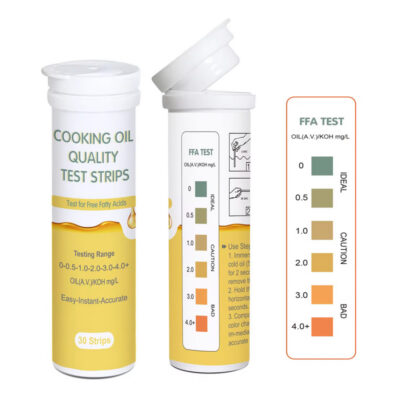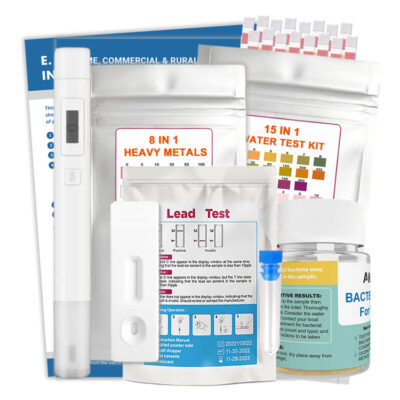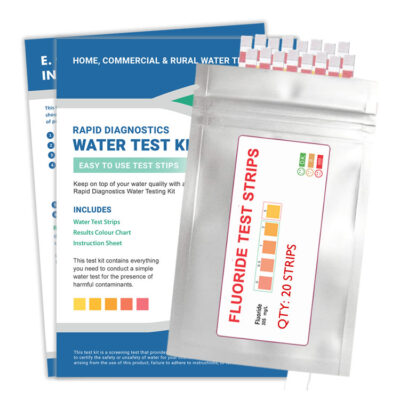In Australia, most of us take water for granted though not all of us are aware that water quality can vary from one location to the next. Water sourced from city reserves travels through many kilometres of plumbing which can sometimes be corroded or damaged causing contamination. In many cases, when pipes burst, they are repaired or patched up. Old house plumbing is also an issue as the lead was initially used to join pipes together and most of us don't look after our pluming until its too late. Country suburbs still reply on rainwater tanks, wells and dams. Most of this water is not monitored, which can be harmful to your health.
How To Test Your Water
If you suspect your water is not clean, the following points will help you determine your water quality. For those that rely on water from tanks, wells or dams, we suggest that you regularly test your water quality and if you have any concerns its best to contact your local council, water board or water testing specialists.
Appearance Test
Inspecting the colour, smell and taste of your water is one of the simplest tests to do. Fill several clean glasses of water from several locations within the property and compare with a glass of filtered of bottled water. Hold the glass in front of a light and closely inspect whether there are any colour difference and any sediment.
If you see a difference between the bottled and tap water, this is always the first sign of water tested. An odd colour can be caused by many contaminants including iron which changes in oxygen to yellow or red a sediment.
- Iron Yellow or colour may cause stains on laundry and fixtures and may have a bitter taste.
- Manganese Causes black or purple colour in water and may stain fixtures, and cause a bitter taste.
Smell / Taste Test
Tasting your water is the next point of action, simply tasting it can help you determine if there is an issue with your water. If your water tastes odd it may have some contamination, following are a few examples.
- Iron Has an odd bitter taste.
- ManganeseHas an odd bitter taste
- Hydrogen Sulphide Smells like rotten eggs.
If you experience any of the above, go onto the next step. If you don't feel confident about testing your water, we suggest getting a professional to do the test for you as they can test up to 50 parameters if they find that your water needs further testing.
Water Test Kits
Purchasing a water test kit gives you an indication of the quality of your water. Most water test kits use test strips with pads dipped into water for a few seconds, remove and wait 60 seconds, and then compare colours on the test kit pads with the colour charts provided.
If you suspect your water is not clean, the following information will help you understand how to test your water with a testing kit and understand what the results mean.
How To Use A Water Test Kit
Testing your water quality with a test kit is simple though it's essential to follow the instructions in detail. Test strips include test pads that react to moisture and deteriorate if touched, left out of the packaging, exposed to sunlight or exposed to moisture.
Once you receive your test kit, open the packaging and remove the instructions. Read the instructions in detail and follow the steps which include the following.
Please Do Not
- Do not touch the test pads at any time as they can be contaminated.
- Do not remove test strips from the foil package unless you intend on using them straight away.
- Do not leave the test strips in direct sunlight as they will degrade.
- Do not expose the test strips to moisture as they will degrade.
- Do not store test strips in a fridge or freezer.
- Do not compare the test strip with the colour chart after 120 seconds of dipping the test strip into the water as they will fade back to their original colour.
Testing Procedure
- Have a pen and piece of paper handy so that you can note down your test results
- Open the plastic packaging, remove instructions and read from start to finish.
- Open silver foil package contains test strips and removes one test strip, place test strip on a flat, clean surface.
- Re-seal the silver foil package and place it back into the plastic package that it came in.
- Dip test kit colour pads in water to be tested, wait a few seconds and remove.
- Place the test strip on a flat surface and wait for 60 seconds.
- Compare the test strip colours with the colour chart provided within 60 to 90 seconds.
- Note down the results of each parameter on a piece of paper.
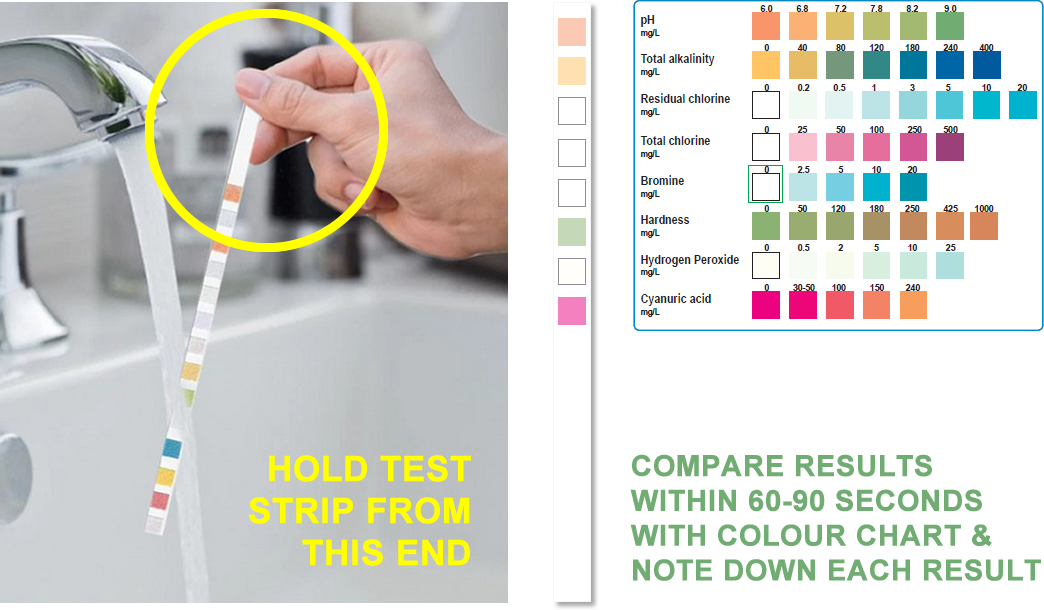
Comparing Results with Colour Chart
When comparing each parameter with the colour chart, it's best to match it with the closest colour. So if calcium is a light blue colour, hover the pest pad over the chart and compare it with the closest colour. Note down the most comparable result and move into the next parameter until all have been noted.
Safe Results Information
Following is a list of test kit parameter levels that are considered safe.
Copper: Copper is a naturally occurring mineral found in rocks and soil and found in low levels in natural water bodies. Copper is an essential element that is required to maintain good health. A reading of 1mg/L is good for aesthetics to prevent taste and staining problems and 2mg/L to prevent many health-related problems.
Iron: Iron is generally added to water as it seeps through the ground, iron in the soil dissolves into the water. Concentrations of iron in water will vary depending on your soil's iron concentration and where the water is located. The Australian Drinking Water Guidelines (ADWG) set out requirements for iron in drinking water. The Guideline/Regulatory Target suggests that below 0.3 mg/L is safe.
Mercury: Mercury is a naturally occurring metal found in air, water and soil. It exists in various forms: elemental (or metallic), inorganic, and organic. These mercury forms differ in their degree of toxicity and their effects on the nervous, digestive and immune systems and the lungs, kidneys, skin and eyes. The health guidelines value for total mercury in drinking water in is 0.001mg/L.
Lead: Problems associated with lead contamination in drinking water do still occur, however, where there is corrosion on pipes that do contain lead in the piping itself or because some pipes are fitted with lead-based solders. The ‘safe’ level of lead fit for consumption as 0.01 mg per litre (this figure has been lowered from the previous recommendation of 0.05 mg/L.
Chromium/Cr: EPA has a drinking water standard of 0.1/mgLor 100 parts per billion (ppb) for total chromium. This includes all forms of chromium, including chromium-6. Water systems are required to test for total chromium.
Zinc: The aesthetic guideline for turbidity is <5 NTU. Zinc – Based on aesthetic considerations (taste), the concentration of zinc in drinking water should be less than 3 mg/L. No health-based guideline value is proposed for zinc. Taste problems can occur if the zinc concentration in drinking water exceeds 3 mg/L.
Manganese: The aesthetic guideline for turbidity is <5 NTU. Zinc – Based on aesthetic Manganese (Mn), an element can impart unpleasant taste and odour in drinking water. Mn also contributes to discoloured water that may result in dirty or stained clothes during washing. Recently, evidence of neurological, cognitive, and neuropsychological effects of manganese exposure from drinking water in children has generated widespread public health concern in some countries. Guidelines recommend an aesthetic guideline of 0.1 mg/L at the customer's tap-based practical experience by utilities as being acceptable to customers.
Fluoride: Fluoridation is the adjustment of fluoride in drinking water to a level that helps protect teeth against decay. Fluoride does not alter the taste or smell of water. The maximum fluoride level in drinking water is 1 mg/L as recommended by the World Health Organization (WHO). As a comparison, the amount of fluoride in children’s toothpaste is 400-500 ppm, and regular toothpaste is 1,000 ppm.
Aluminium: Aluminum-contaminated water has no taste or odour. However, very high aluminium levels can sometimes cause water to have a bluish colour. The guidelines for aluminium levels in community water supplies should not exceed 0.2 mg/L. Water that contains more than 0.2mg/L of aluminium should not be used for drinking water or to prepare beverages or infant formula.
Calcium: Water containing calcium carbonate at concentrations below 60 mg/l is generally considered soft; 60–120 mg/l, moderately hard; 120–180 mg/l, hard; and more than 180 mg/l, very hard. Recommendations have been made for the maximum and minimum levels of calcium 40–80 mg/L.
Potassium permanganate: Potassium permanganate is used extensively in the water treatment industry. It is used as a regeneration chemical to remove iron and hydrogen sulfide (rotten egg smell) from well water via a "Manganese Greens and" Filter. "Pot-Perm" is also obtainable at pool supply stores and is used additionally to treat wastewater. Historically it was used to disinfect drinking water[9][10] and turn the water pink. It currently finds application in the control of nuisance organisms such as zebra mussels in freshwater collection and treatment systems. 0.25 mg/L is considered to be safe.
pH: pH is the indicator for acidity and alkalinity. A pH value of 7 means that the water is neutral. The lower value indicates that the water is acidic, and the higher value is a sign of alkalinity. A good pH reading should be 6.5 to 8.5. Below 6.5 can mean that your water could have metal ions such as iron, manganese, copper, lead, and zinc. When pH levels over 8.5 are detected, you will notice that the taste can become bitter. This may mean that you have lead, calcium and magnesium carbonate building up in your pipes.
Total Alkalinity: Alkalinity is a measure of the capacity of water to neutralise acids or hydrogen ions. Alkalinity can sometimes be referred to as "Carbonate hardness". Alkalinity acts as a buffer if any changes are made to the water's pH value. The Alkalinity in the water will help keep the water's pH stabilised. The drinking water and all water should be a pH of 7, meaning that it's neutral. High alkalinity is good to have in our drinking water because it keeps the water safe for us to drink. The amount of alkalinity in our water is 20-200 mg/L for typical drinking water. Alkalinity is dissolved minerals in the water that help neutralise the water we drink.
Hardness: Drinking hard water is generally safe. It may actually be beneficial to your health. The benefits of hard water include fulfilling your essential minerals' dietary needs, such as calcium and magnesium. The water that runs through your house and in public buildings has varying hardness levels based on calcium carbonate concentration. According to guidelines water with less than 60 mg/L of calcium carbonate is considered soft, 61-120 mg/L is moderately hard, 121-180 mg/L is hard, and above 180 mg/L is deemed very hard.
Cyanuric Acid: Cyanuric acid, as its name suggests, is an ‘acid’. Like many commercially available acids, it is sold as a white crystalline powder. It can easily dissolve in water and has a little overall effect on other pool chemicals, such as pH, alkalinity and dissolved solids. Unlike other ‘acids’, it is commonly referred to as a chlorine stabiliser or conditioner, forming a weak and temporary chemical bond with chlorine. This means it will chemically hold onto free chlorine in the water, slow down overall oxidation reaction rates and most importantly, protect chlorine from the sun’s UV rays until the chlorine is consumed for oxidation or disinfection of material in the pool. For drinking water, the recommended levels are 0 mg/L.
Bromine: Bromine is most commonly used in swimming pools and marketed as a replacement for chlorine. One advantage is that there are no asthma-related problems for individuals in contact with the disinfected water (e.g. swimmers and/or lifeguards).2 Bromine in various chemical forms is also used in water fountains and cooling towers. In general, the use of bromine in potable water disinfection is minimal. It is impeded by costs, concerns about brominated DBPs, and a lack of knowledge on its efficacy in certain areas. For drinking water, the recommended levels are 0 mg/L.
Free Chlorine: The presence of free chlorine (also known as chlorine residual, free chlorine residual, residual chlorine) in drinking water indicates that: 1) a sufficient amount of chlorine was added initially to the water to inactivate the bacteria and some viruses that cause diarrhea; and, 2) the water is protected from re-contamination during storage. The presence of free chlorine in drinking water is correlated with the absence of most disease-causing organisms, and thus is a measure of the potability of water. WHO guideline value for free chlorine in drinking water, which is 0.25mg/L value.
Total Chlorine: Total chlorine is the sum of combined chlorine and free chlorine, which is useful to measure for various reasons. True chlorine is elementary to test for in water when compared to free chlorine or combined chlorine, which is why many of the more inexpensive chlorine measurement tests will specifically test for total chlorine. In clean water, the amount of total chlorine can determine the amount of free chlorine in the water since combined chlorine should be 0 mg/L.
Ammonium Chloride: Natural levels in groundwater are usually contained below 0.2 mg of ammonia per litre. Ammonia may be present in drinking-waters a result of disinfection with chloramines. The presence of ammonia at higher levels is an indicator of fecal pollution. Taste and odour problems and decreased disinfection efficiency are expected if drinking-water containing more than 0.2 mg of ammonia per litre is chlorinated. Cement mortar used for coating water pipes' insides may release considerable amounts of ammonia into drinking-water and compromise disinfection with chlorine. For drinking water, the recommended levels are 0 mg/L.
Nitrate: Much of the water supplied in many parts of Australia comes from the ground or bore water which can often contain nitrate. Elevated levels are usually the result of the natural process of underground plant decay. Over time nitrates can accumulate in groundwater that may then be used as a drinking water supply. Nitrate concentrations above 50mg/L can cause adverse health effects in infants under three months of age, and nitrate concentrations above 100 mg/L can affect pregnant women and adults. Less than 50mg/L is safe to drink. 50mg/L – 100mg/L is safe to drink for adults, including pregnant women. More than 100mg/L drinking not recommended for any age.
Nitrite: Nitrites are salt which can be naturally occurring in groundwater. Nitrites come from fertilisers through run-off water, sewage, and mineral deposits. Unfortunately, it can stimulate the growth of bacteria when introduced in high levels into a water body. High levels of nitrites are toxic to humans and animals, especially infants. It can enter the body as nitrate, a nutrient essential to plant growth and be converted into nitrite, which disrupts the oxygen delivering ability of hemoglobin in the bloodstream. The WHO Guideline for Nitrite in water is a maximum of 1 mg/L.
Hydrogen Peroxide: Hydrogen peroxide is a clear, odourless, and colourless liquid consisting of hydrogen and oxygen. Drinking water contaminated with hydrogen peroxide can have many side effects. The severity of the side effects depends on the quantity and concentration of the hydrogen peroxide consumed. For drinking water, the recommended levels are 0 mg/L.
Iodine: Iodine is a naturally occurring element that can enter water sources through leaching from soils and rocks. While essential in small amounts for thyroid function, excessive iodine intake can lead to health issues such as thyroid gland dysfunction. The Australian Drinking Water Guidelines (ADWG) set a health-based guideline value for iodine at 0.5 mg/L.
Potassium (Kalium): Potassium is an essential mineral for human health, playing a crucial role in cell function and fluid balance. It is naturally present in various water sources. The ADWG does not specify a health-based or aesthetic guideline value for potassium in drinking water, as it is rarely found at levels that could pose health concerns.
Sulfate: Sulfate occurs naturally in water due to the dissolution of minerals like gypsum and epsomite. The ADWG provides an aesthetic guideline value of 250 mg/L for sulfate, as higher concentrations can impart a bitter taste to the water. While sulfate is not considered a significant health concern at typical concentrations, levels exceeding 500 mg/L may have a laxative effect, especially when combined with magnesium or sodium.
Sulfite: Sulfite is not commonly found in natural water sources but may be present due to industrial pollution or as a byproduct of water treatment processes. The ADWG does not establish a specific guideline value for sulfite in drinking water. However, elevated levels can lead to taste and odor issues and may pose health risks, particularly for individuals with sulfite sensitivities.
Cobalt: Cobalt is a trace element that can enter water supplies through the erosion of natural deposits or industrial discharges. The ADWG does not specify a guideline value for cobalt in drinking water, as it is typically present at very low concentrations that are not considered a health risk. However, excessive exposure to cobalt can lead to health issues, including effects on the heart and thyroid.
Magnesium: Magnesium is a naturally occurring mineral essential for human health, contributing to muscle and nerve function, as well as bone strength. It is commonly found in water sources and contributes to water hardness. The ADWG does not set a health-based guideline value for magnesium in drinking water. However, water hardness classifications are based on the combined concentrations of calcium and magnesium, with levels below 60 mg/L considered soft and above 200 mg/L considered hard. While hard water is not a health concern, it can cause scaling in pipes and appliances.
More information is available from the Australian Drinking Water Guidelines (2011) - Updated May 2019
Professional Water Testing
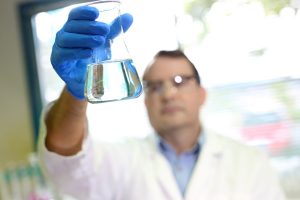
If you find that your water is contaminated or not comfortable running your tests, contacting a professional water filter specialist or water tester is always a right choice. They can determine if your water is safe though if an issue is detected, they will not provide a solution unless the problem is simple to detect. Water contamination issues should be inspected by a plumber or your local water board.
You can expect to pay $100-$200 for tests you post to a testing lab or $300+ to have a professional water tester visit your property. Water filter specialists may be able to test the quality of your water, and the cost is generally included in the price of a water filtration system.
Common Causes of Water Contamination
There are many reasons for water contamination; the following are the most common.
- Sewage & Waste Water Sewage, farm and factory liquid waste are sometimes discharged into water sources which can mix in with local water supply. These chemicals can be poisonous for animals, plants and humans.
- Rubbish Dumping Dumping of rubbish into water lakes and rivers causes problems with water quality. These include plastics, aluminium, steel, Styrofoam and waste chemicals. Many of these can take hundreds of years to decay in water.
- Industrial Waste Industrial waste is one of the worst water pollutants. It includes dangerous chemicals including asbestos, mercury, lead and mercury, which are hazardous to people, plants, animals, and the environment.
- Acid Rain Acid rain is common in industrial and highly polluted areas. When it rains, acidic particles will mix with vapour resulting in acid rain collected by rainwater tanks.
- Eutrophication happens when there is an increase in nutrients in water bodies. This causes a bloom of algae in the water. Eutrophication depletes oxygen in the water which affects aquatic animal population and can contaminate drinking water.
- Lead Homes built before 1986 most likely have lead in pipes, fixtures and solder. When they corrode significant amounts of lead enters into water boiling water.
To learn more on How To Test Your Water, visit our FAQ's page or visit your local water board website. More information is also available from the Australian Drinking Water Guidelines (2011) - Updated May 2019.



